The content of this website is no longer being updated. For information on current assessment activities, please visit http://www.globalchange.gov/what-we-do/assessment
Northeast
Climate on the Move: Changing Summers in New Hampshire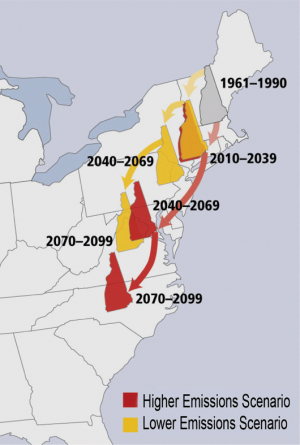 Yellow arrows track what summers are projected to feel like under a lower emissions scenario,1 while red arrows track projections for a higher emissions scenario1 (referred to as “even higher” in figure from Global Climate Change section). For example, under the higher emissions scenario,1 by late this century residents of New Hampshire would experience a summer climate more like what occurs today in North Carolina.2 Image Reference: Hayhoe et al.2; Image Source: Frumhoff et al.3 The Northeast has significant geographic and climatic diversity within its relatively small area. The character and economy of the Northeast have been shaped by many aspects of its climate including its snowy winters, colorful autumns, and variety of extreme events such as nor’easters, ice storms, and heat waves. This familiar climate has already begun changing in noticeable ways.
Yellow arrows track what summers are projected to feel like under a lower emissions scenario,1 while red arrows track projections for a higher emissions scenario1 (referred to as “even higher” in figure from Global Climate Change section). For example, under the higher emissions scenario,1 by late this century residents of New Hampshire would experience a summer climate more like what occurs today in North Carolina.2 Image Reference: Hayhoe et al.2; Image Source: Frumhoff et al.3 The Northeast has significant geographic and climatic diversity within its relatively small area. The character and economy of the Northeast have been shaped by many aspects of its climate including its snowy winters, colorful autumns, and variety of extreme events such as nor’easters, ice storms, and heat waves. This familiar climate has already begun changing in noticeable ways.
Since 1970, the annual average temperature in the Northeast has increased by 2°F, with winter temperatures rising twice this much.4 Warming has resulted in many other climate-related changes, including:
- More frequent days with temperatures above 90°F
- A longer growing season
- Increased heavy precipitation
- Less winter precipitation falling as snow and more as rain
- Reduced snowpack
- Earlier breakup of winter ice on lakes and rivers
- Earlier spring snowmelt resulting in earlier peak river flows
- Rising sea surface temperatures and sea level
Each of these observed changes is consistent with the changes expected in this region from global warming. The Northeast is projected to face continued warming and more extensive climate-related changes, some of which could dramatically alter the region’s economy, landscape, character, and quality of life.
Over the next several decades, temperatures in the Northeast are projected to rise an additional 2.5 to 4°F in winter and 1.5 to 3.5°F in summer. By mid-century and beyond, however, today’s emissions choices would generate starkly different climate futures; the lower the emissions, the smaller the climatic changes and resulting impacts.4,2 By late this century, under a higher emissions scenario1:
- Winters in the Northeast are projected to be much shorter with fewer cold days and more precipitation.
- The length of the winter snow season would be cut in half across northern New York, Vermont, New Hampshire, and Maine, and reduced to a week or two in southern parts of the region.
- Cities that today experience few days above 100°F each summer would average 20 such days per summer, while certain cities, such as Hartford and Philadelphia, would average nearly 30 days over 100°F.
- Short-term (one- to three-month) droughts are projected to occur as frequently as once each summer in the Catskill and Adirondack Mountains, and across the New England states.
- Hot summer conditions would arrive three weeks earlier and last three weeks longer into the fall.
- Sea level in this region is projected to rise more than the global average, see Global and National Climate Change and Coasts sections for more information on sea-level rise .
Rising Temperatures
Extreme heat and declining air quality are likely to pose increasing problems for human health, especially in urban areas.
Projected Days per Year over 90°F in Boston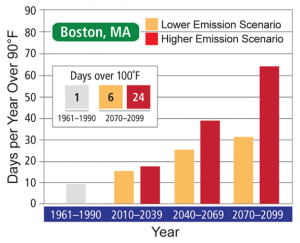 The graph shows model projections of the number of summer days with temperatures over 90°F in Boston, Massachusetts, under lower and higher (referred to as “even higher” in figure from Global Climate Change section) emissions scenarios.1 The inset shows projected days over 100°F.2 Image Reference: Hayhoe et al.2Heat waves, which are currently rare in the region, are projected to become much more commonplace in a warmer future, with major implications for human health (see Human Health sector).5,6
The graph shows model projections of the number of summer days with temperatures over 90°F in Boston, Massachusetts, under lower and higher (referred to as “even higher” in figure from Global Climate Change section) emissions scenarios.1 The inset shows projected days over 100°F.2 Image Reference: Hayhoe et al.2Heat waves, which are currently rare in the region, are projected to become much more commonplace in a warmer future, with major implications for human health (see Human Health sector).5,6
In addition to the physiological stresses associated with hotter days and nights,7 for cities that now experience ozone pollution problems, the number of days that fail to meet federal air quality standards is projected to increase with rising temperatures if there are no additional controls on ozone-causing pollutants5,8 (see Human Health sector). Sharp reductions in emissions will be needed to keep ozone within existing standards.
Projected changes in summer heat (see figure on left) provide a clear sense of how different the climate of the Northeast is projected to be under lower versus higher emissions scenarios. Changes of this kind will require greater use of air conditioning (see Energy sector).
Agriculture
Agricultural production, including dairy, fruit, and maple syrup, are likely to be adversely affected as favorable climates shift.
Projected Shifts in Trees Species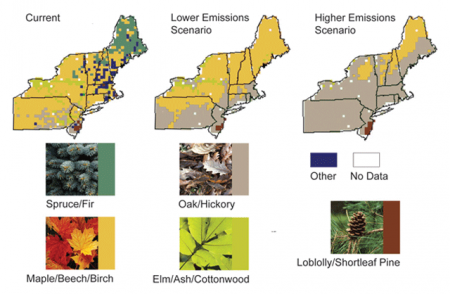 Much of the Northeast’s forest is composed of the hardwoods maple, beech, and birch, while mountain areas and more northern parts of the region are dominated by spruce/fir forests. As climate changes over this century, suitable habitat for spruce and fir is expected to contract dramatically. Suitable maple/beech/birch habitat is projected to shift significantly northward under a higher emissions scenario (referred to as “even higher” in figure from Global Climate Change section),1 but to shift far less under a lower emissions scenario.1,9 Other studies of tree species shifts suggest even more dramatic changes than those shown here (see Tree species shifts in Ecosystems sector). Image Source: adapted from Iverson et al.10Large portions of the Northeast are likelyat least two-thirds chance of occurring to become unsuitable for growing popular varieties of apples, blueberries, and cranberries under a higher emissions scenario.1,11,9 Climate conditions suitable for maple/beech/birch forests are projected to shift dramatically northward (see figure on right), eventually leaving only a small portion of the Northeast with a maple sugar business.10
Much of the Northeast’s forest is composed of the hardwoods maple, beech, and birch, while mountain areas and more northern parts of the region are dominated by spruce/fir forests. As climate changes over this century, suitable habitat for spruce and fir is expected to contract dramatically. Suitable maple/beech/birch habitat is projected to shift significantly northward under a higher emissions scenario (referred to as “even higher” in figure from Global Climate Change section),1 but to shift far less under a lower emissions scenario.1,9 Other studies of tree species shifts suggest even more dramatic changes than those shown here (see Tree species shifts in Ecosystems sector). Image Source: adapted from Iverson et al.10Large portions of the Northeast are likelyat least two-thirds chance of occurring to become unsuitable for growing popular varieties of apples, blueberries, and cranberries under a higher emissions scenario.1,11,9 Climate conditions suitable for maple/beech/birch forests are projected to shift dramatically northward (see figure on right), eventually leaving only a small portion of the Northeast with a maple sugar business.10
The dairy industry is the most important agricultural sector in this region, with annual production worth $3.6 billion.12 Heat stress in dairy cows depresses both milk production and birth rates for periods of weeks to months.13,14 By late this century, all but the northern parts of Maine, New Hampshire, New York, and Vermont are projected to suffer declines in July milk production under the higher emissions scenario. In parts of Connecticut, Massachusetts, New Jersey, New York, and Pennsylvania, a large decline in milk production, up to 20 percent or greater, is projected. Under the lower emissions scenario, however, reductions in milk production of up to 10 percent remain confined primarily to the southern parts of the region.
This analysis used average monthly temperature and humidity data that do not capture daily variations in heat stress and projected increases in extreme heat. Nor did the analysis directly consider farmer responses, such as installation of potentially costly cooling systems. On balance, these projections are likely to underestimate impacts on the dairy industry.4
Sea-level Rise and Flooding
Severe flooding due to sea-level rise and heavy downpours is likelyat least two-thirds chance of occurring to occur more frequently.
Increased Flood Risk in New York City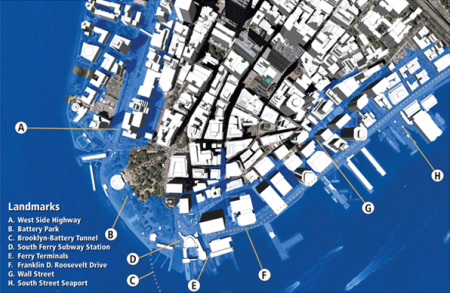 The light blue area above depicts today’s FEMA 100-year flood zone for the city (the area of the city that is expected to be flooded once every 100 years). With rising sea levels, a 100-year flood at the end of this century (not mapped here) is projected to inundate a far larger area of New York City, especially under the higher emissions scenario.1 Critical transportation infrastructure located in the Battery area of lower Manhattan could be flooded far more frequently unless protected. The increased likelihood of flooding is causing planners to look into building storm-surge barriers in New York Harbor to protect downtown New York City. 3,15,16 Image Reference: Kirshen et al.17; Image Source: Frumhoff et al.3The densely populated coasts of the Northeast face substantial increases in the extent and frequency of storm surge, coastal flooding, erosion, property damage, and loss of wetlands.18,17 New York state alone has more than $2.3 trillion in insured coastal property.19 Much of this coastline is exceptionally vulnerable to sea-level rise and related impacts. Some major insurers have withdrawn coverage from thousands of homeowners in coastal areas of the Northeast, including New York City.
The light blue area above depicts today’s FEMA 100-year flood zone for the city (the area of the city that is expected to be flooded once every 100 years). With rising sea levels, a 100-year flood at the end of this century (not mapped here) is projected to inundate a far larger area of New York City, especially under the higher emissions scenario.1 Critical transportation infrastructure located in the Battery area of lower Manhattan could be flooded far more frequently unless protected. The increased likelihood of flooding is causing planners to look into building storm-surge barriers in New York Harbor to protect downtown New York City. 3,15,16 Image Reference: Kirshen et al.17; Image Source: Frumhoff et al.3The densely populated coasts of the Northeast face substantial increases in the extent and frequency of storm surge, coastal flooding, erosion, property damage, and loss of wetlands.18,17 New York state alone has more than $2.3 trillion in insured coastal property.19 Much of this coastline is exceptionally vulnerable to sea-level rise and related impacts. Some major insurers have withdrawn coverage from thousands of homeowners in coastal areas of the Northeast, including New York City.
Rising sea level is projected to increase the frequency and severity of damaging storm surges and flooding. Under a higher emissions scenario,1 what is now considered a once-in-a-century coastal flood in New York City is projected to occur at least twice as often by mid-century, and 10 times as often (or once per decade on average) by late this century. With a lower emissions scenario,1 today’s 100-year flood is projected to occur once every 22 years on average by late this century.17
Adaptation: Raising a Sewage Treatment Plant in Boston
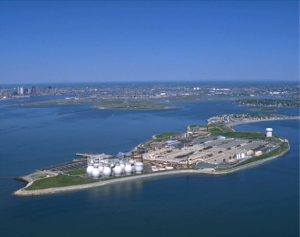 Boston’s Deer Island sewage treatment plant was designed and built taking future sea-level rise into consideration. Because the level of the plant relative to the level of the ocean at the outfall is critical to the amount of rainwater and sewage that can be treated, the plant was built 1.9 feet higher than it would otherwise have been to accommodate the amount of sea-level rise projected to occur by 2050, the planned life of the facility.
Boston’s Deer Island sewage treatment plant was designed and built taking future sea-level rise into consideration. Because the level of the plant relative to the level of the ocean at the outfall is critical to the amount of rainwater and sewage that can be treated, the plant was built 1.9 feet higher than it would otherwise have been to accommodate the amount of sea-level rise projected to occur by 2050, the planned life of the facility.
The planners recognized that the future would be different from the past and they decided to plan for the future based on the best available information. They assessed what could be easily and inexpensively changed at a later date versus those things that would be more difficult and expensive to change later. For example, increasing the plant’s height would be less costly to incorporate in the original design, while protective barriers could be added at a later date, as needed, at a relatively small cost.
Winter Recreation
The projected reduction in snow cover will adversely affect winter recreation and the industries that rely upon it.
Ski Areas at Risk under Higher Emission Scenario91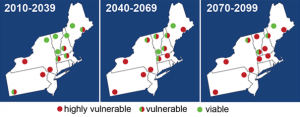 The ski resorts in the Northeast have three climate-related criteria that need to be met for them to remain viable: the average length of the ski season must be at least 100 days; there must be a good probability of being open during the lucrative winter holiday week between Christmas and the New Year; and there must be enough nights that are sufficiently cold to enable snowmaking operations. By these standards, only one area in the region (not surprisingly, the one located farthest north) is projected to be able to support viable ski resorts by the end of this century under a higher emissions scenario (referred to as “even higher” in figure from Global Climate Change section).1,20 Image Reference: Scott et al.21; Image Source: Frumhoff et al.3Winter snow and ice sports, which contribute some $7.6 billion annually to the regional economy, will be particularly affected by warming.21 Of this total, alpine skiing and other snow sports (not including snowmobiling) account for $4.6 billion annually. Snowmobiling, which now rivals skiing as the largest winter recreation industry in the nation, accounts for the remaining $3 billion.22 Other winter traditions, ranging from skating and ice fishing on frozen ponds and lakes, to cross-country (Nordic) skiing, snowshoeing, and dog sledding, are integral to the character of the Northeast, and for many residents and visitors, its desirable quality of life.
The ski resorts in the Northeast have three climate-related criteria that need to be met for them to remain viable: the average length of the ski season must be at least 100 days; there must be a good probability of being open during the lucrative winter holiday week between Christmas and the New Year; and there must be enough nights that are sufficiently cold to enable snowmaking operations. By these standards, only one area in the region (not surprisingly, the one located farthest north) is projected to be able to support viable ski resorts by the end of this century under a higher emissions scenario (referred to as “even higher” in figure from Global Climate Change section).1,20 Image Reference: Scott et al.21; Image Source: Frumhoff et al.3Winter snow and ice sports, which contribute some $7.6 billion annually to the regional economy, will be particularly affected by warming.21 Of this total, alpine skiing and other snow sports (not including snowmobiling) account for $4.6 billion annually. Snowmobiling, which now rivals skiing as the largest winter recreation industry in the nation, accounts for the remaining $3 billion.22 Other winter traditions, ranging from skating and ice fishing on frozen ponds and lakes, to cross-country (Nordic) skiing, snowshoeing, and dog sledding, are integral to the character of the Northeast, and for many residents and visitors, its desirable quality of life.
Warmer winters will shorten the average ski and snowboard seasons, increase artificial snowmaking requirements, and drive up operating costs. While snowmaking can enhance the prospects for ski resort success, it requires a great deal of water and energy, as well as very cold nights, which are becoming less frequent. Without the opportunity to benefit from snowmaking, the prospects for the snowmobiling industry are even worse. Most of the region is likely to have a marginal or non-existent snowmobile season by mid-century.
Fisheries
The center of lobster fisheries is projected to continue its northward shift and the cod fishery on Georges Bank is likelyat least two-thirds chance of occurring to be diminished.
Lobster catch has increased dramatically in the Northeast as a whole over the past three decades, though not uniformly.23,24 Catches in the southern part of the region peaked in the mid-1990s, and have since declined sharply, beginning with a 1997 die-off in Rhode Island and Buzzards Bay (Massachusetts) associated with the onset of a temperature-sensitive bacterial shell disease, and accelerated by a 1999 lobster die-off in Long Island Sound. Currently, the southern extent of the commercial lobster harvest appears to be limited by this temperature-sensitive shell disease, and these effects are expected to increase as near-shore water temperatures rise above the threshold for this disease. Analyses also suggest that lobster survival and settlement in northern regions of the Gulf of Maine could be increased by warming water, a longer growing season, more rapid growth, an earlier hatching season, an increase in nursery grounds suitable for larvae, and faster development of plankton.25
Cod populations throughout the North Atlantic are adapted to a wide range of seasonal ocean temperatures, including average annual temperatures near the seafloor ranging from 36 to 54°F. Large populations of cod are generally not found above the 54°F threshold.26 Temperature also influences both the location and timing of spawning, which in turn affects the subsequent growth and survival of young cod. Increases in average annual bottom temperatures above 47°F lead to a decline in growth and survival.27,28 Projections of warming indicate that both the 47°F and the 54°F thresholds will be met or exceeded in this century under a higher emissions scenario.3 Climate change will thus introduce an additional stress to an already-stressed fishery.26
References
- 1. a. b. c. d. e. f. g. h. i. j. k. l. [91] various. footnote 91., 2009.
- 2. a. b. c. d. e. [359] Hayhoe, K., C. P. Wake, B. Anderson, X. - Z. Liang, E. Maurer, J. Zhu, J. Bradbury, A. DeGaetano, A. Hertel, and D. Wuebbles. "Regional Climate Change Projections for the Northeast U.S." Mitigation and Adaptation Strategies for Global Change 13, no. 5-6 (2008): 425-436.
- 3. a. b. c. d. e. [234] Frumhoff, P. C., J. J. McCarthy, J. Melillo, S. C. Moser, and D. Wuebbles. Confronting Climate Change in the U. S. Northeast: Science, Impacts, and Solutions. Vol. Synthesis Report of the Northeast Climate Impacts Assessment. Cambridge, MA: Union of Concerned Scientists, 2007.
- 4. a. b. c. [150] Hayhoe, K., C. P. Wake, T. G. Huntington, L. F. Luo, M. D. Schwartz, J. Sheffield, E. Wood, B. Anderson, J. Bradbury, A. DeGaetano et al. "Past and Future Changes in Climate and Hydrological Indicators in the U.S. Northeast." Climate Dynamics 28, no. 4 (2007): 381-407.
- 5. a. b. [163] Ebi, K. L., J. Balbus, P. L. Kinney, E. Lipp, D. M. Mills, M. S. O'Neill, and M. Wilson. "Effects of Global Change on Human Health." In Analyses of the Effects of Global Change on Human Health and Welfare and Human Systems, edited by J. L. Gamble, 39-87. Vol. Synthesis and Assessment Product 4.6. Washington, D.C.: U.S. Environmental Protection Agency, 2008.
- 6. [68] Gutowski, W. J., G. C. Hegerl, G. J. Holland, T. R. Knutson, L. Mearns, R. J. Stouffer, P. J. Webster, M. F. Wehner, and F. W. Zwiers. "Causes of Observed Changes in Extremes and Projections of Future Changes." In Weather and Climate Extremes in a Changing Climate: Regions of Focus: North America, Hawaii, Caribbean, and U.S. Pacific Islands, edited by T. R. Karl, G. A. Meehl, C. D. Miller, S. J. Hassol, A. M. Waple and W. L. Murray, 81-116. Vol. Synthesis and Assessment Product 3.3. Washington, D.C.: U.S. Climate Change Science Program, 2008.
- 7. [360] of and Hygiene, New York City Department Health Mental. Deaths Associated with Heat Waves in 2006 In NYC Vital Signs: Investigation Report, Special Report. New York, NY: Department of Health and Mental Hygiene, 2006.
- 8. [361] Kunkel, K. E., H. C. Huang, X. - Z. Liang, J. - T. Lin, D. Wuebbles, Z. Tao, A. Williams, M. Caughey, J. Zhu, and K. Hayhoe. "Sensitivity of Future Ozone Concentrations in the Northeast U.S. to Regional Climate Change." Mitigation and Adaptation Strategies for Global Change 13, no. 5-6 (2008): 597-606.
- 9. a. b. [363] various. footnote 363., 2009.
- 10. a. b. [364] Iverson, L., A. Prasad, and S. Matthews. "Potential Changes in Suitable Habitat for 134 Tree Species in the Northeastern United States." Mitigation and Adaptation Strategies for Global Change 13, no. 5-6 (2008): 487-516.
- 11. [362] Hauagge, R., and J. N. Cummins. "Phenotypic Variation of Length of Bud Dormancy in Apple Cultivars and Related Malus Species." Journal of the American Society For Horticultural Science 116, no. 1 (1991): 100-106.
- 12. [365] of Agriculture, Department U. S.. Statistics by State. U.S. Department of Agriculture (USDA) National Agriculture Statistics Service (NASS), 2002.
- 13. [193] Hatfield, J., K. Boote, P. Fay, L. Hahn, C. Izaurralde, B. A. Kimball, T. Mader, J. Morgan, D. Ort, W. Polley et al. "Agriculture." In The Effects of Climate Change on Agriculture, Land Resources, and Biodiversity in the United States, edited by P. Backlund, A. Janetos, D. Schimel, J. Hatfield, K. Boote, P. Fay, L. Hahn, C. Izaurralde, B. A. Kimball, T. Mader et al., 21-74. Vol. Synthesis and Assessment Product 4.3. Washington, D.C.: U.S. Department of Agriculture, 2008.
- 14. [366] St. Pierre, N. R., B. Cobanov, and G. Schnitkey. "Economic Losses from Heat Stress by U.S. Livestock Industries." Journal of Dairy Science 86, no. Supplement 1 (2003): E52-E77.
- 15. [370] Bowman, M., D. Hill, F. Buonaiuto, B. Colle, R. Flood, R. Wilson, R. Hunter, and J. Wang. "Threats and Responses Associated with Rapid Climate Change in Metropolitan New York." In Sudden and Disruptive Climate Change: Exploring the Real Risks and How We Can Avoid Them, edited by M. C. MacCracken, F. Moore and J. C. Topping Jr., 119-142. London, UK and Sterling, VA: Earthscan, 2008.
- 16. [371] Titus, J. G., K. E. Anderson, D. R. Cahoon, D. B. Gesch, S. K. Gill, B. T. Butierrez, E. R. Thieler, and S. J. Williams. "Ongoing Adaptation." In Coastal Elevations and Sensitivity to Sea-level Rise: A Focus on the Mid-Atlantic Region, 157-162. Vol. Synthesis Assessment Product 4.1. Washington, D.C.: U.S. Environmental Protection Agency, 2009.
- 17. a. b. c. [369] Kirshen, P., C. Watson, E. Douglas, A. Gontz, J. Lee, and Y. Tian. "Coastal Flooding in the Northeastern United States Due to Climate Change." Mitigation and Adaptation Strategies for Global Change 13, no. 5-6 (2008): 437-451.
- 18. [367] Gornitz, V., S. Couch, and E. K. Hartig. "Impacts of Sea Level Rise in the New York City Metropolitan Area." Global and Planetary Change 32, no. 1 (2001): 61-88.
- 19. [368] Corporation, AIR Worldwide. The Coastline at Risk: 2008 Update to the Estimated Insured Value of U.S. Coastal Properties. Boston, MA: AIR Worldwide Corporation, 2008.
- 20. [373] NECIA. Climate Change in the U. S. Northeast: A Report of the Northeast Climate Impacts Assessment. Cambridge, MA: Union of Concerned Scientists, 2006.
- 21. a. b. [342] Scott, D., J. Dawson, and B. Jones. "Climate Change Vulnerability of the U.S. Northeast Winter Recreation– Tourism Sector." Mitigation and Adaptation Strategies for Global Change 13, no. 5-6 (2008): 577-596.
- 22. [372] Association, International Snowmobile Manufacturers. International Snowmobile Industry Facts and Figures., 2006.
- 23. [374] Commission, Atlantic States Marine Fisheries. American Lobster., 2005.
- 24. [375] Fogarty, M. J.. "Populations, Fisheries, and Management." In The Biology of the American Lobster Homarus americanus, edited by J. R. Factor, 111-137. San Diego, CA: Academic Press, 1995.
- 25. [376] Glenn, R. P., and T. L. Pugh. "Epizootic Shell Disease in American Lobster (Homarus americanus) in Massachusetts Coastal Waters: Interactions of Temperature, Maturity, and Intermolt Duration." Journal of Crustacean Biology 26, no. 4 (2006): 639-645.
- 26. a. b. [377] Fogarty, M., L. Incze, K. Hayhoe, D. Mountain, and J. Manning. "Potential Climate Change Impacts on Atlantic Cod (Gadus morhua) off the Northeastern United States." Mitigation and Adaptation Strategies for Global Change 13, no. 5-6 (2008): 453-466.
- 27. [378] Dutil, J. - D., and K. Brander. "Comparing Productivity of North Atlantic Cod (Gadus morhua) Stocks and Limits to Growth Production." Fisheries Oceanography 12, no. 4-5 (2003): 502-512.
- 28. [379] Drinkwater, K. F.. "The Response of Atlantic Cod (Gadus morhua) to Future Climate Change." ICES Journal of Marine Science 62, no. 7 (2005): 1327-1337.